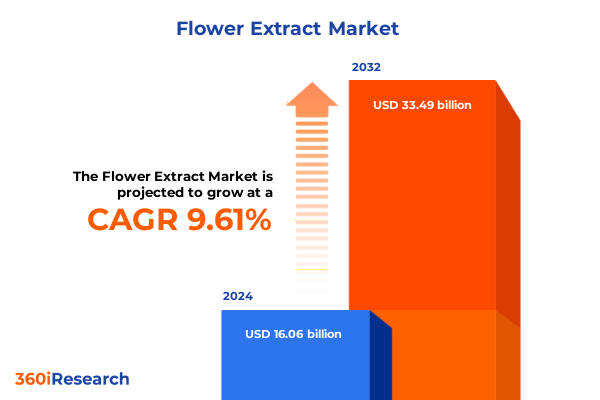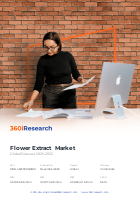The Flower Extract Market size was estimated at USD 16.06 billion in 2024 and expected to reach USD 17.49 billion in 2025, at a CAGR of 9.61% to reach USD 33.49 billion by 2032.

Unveiling the Transformative Power of Flower Extracts Amidst Evolving Consumer Preferences, Regulatory Challenges, and Sustainability Imperatives
The flower extract industry is experiencing an unprecedented surge in demand as consumers increasingly prioritize natural, plant-based ingredients in their personal care, cosmetic, and wellness routines. Shoppers are meticulously examining product labels, opting for formulations free of parabens, phthalates, and sulfates, while seeking botanical extracts like rose, lavender, and jasmine for their perceived safety and efficacy. This clean beauty movement is no longer niche; retailers are dedicating entire store sections to products bearing “Made Without” certifications, underscoring the mainstream embrace of transparent, ingredient-focused branding. In parallel, the rising consumer appetite for holistic wellness has propelled flower extracts from aromatic enhancers to multifunctional actives, valued for antioxidant, anti-inflammatory, and calming properties.
From Boutique Botanicals to Biotechnological Breakthroughs Charting the Major Market Trends Transforming Global Flower Extract Sourcing and Application in 2025
The flower extract landscape is being reshaped by rapid technological innovations and shifting regulatory environments. Biotechnology is emerging as a cornerstone, with lab-grown, bioidentical compounds offering consistent purity and reduced ecological impact compared to traditional harvest methods. Leading ingredient suppliers are investing heavily in fermentation and cell-culture platforms to produce high-performance squalane, essential oils, and novel terpenes at scale. At the same time, the proliferation of AI-driven product lifecycle management tools is enabling companies to model the effect of tariff fluctuations, climate risks, and consumer trends on ingredient costs and availability. Cyber-enabled sourcing platforms now provide real-time transparency on crop yields and shipping timelines, fostering more resilient supply chains.
Assessing the Far-Reaching Consequences of 2025’s Comprehensive U.S. Tariff Regime on the Flower Extract Supply Chain and Industry Dynamics
The introduction of comprehensive U.S. tariffs in early 2025 has imposed material challenges on flower extract sourcing and pricing. A universal 10% levy on all imports effective April 5, 2025, coupled with higher rates for select partners, has driven up raw material costs and forced formulators to reconsider global procurement strategies. For cut flowers and raw botanical oils commonly sourced from South America and Asia, the tariff has translated into an estimated $25 million incremental cost ahead of peak seasonal demand periods. Independent perfumers and niche fragrance houses report that while some can absorb the incremental surcharge, many will need to adjust ingredient lists or pursue regional suppliers to maintain price competitiveness.
Decoding the Multifaceted Market Segmentation of Flower Extracts Across Extraction Methods, Forms, Types, Dosage Forms, and Applications to Illuminate Consumer Preferences and Manufacturing Strategies
Understanding the flower extract market requires a granular segmentation lens that spans extraction technologies, product forms, botanical sources, dosage applications, end-use sectors, and consumer touchpoints. Extraction methodologies range from cold-press techniques and solvent-driven approaches-including acetone, ethanol, and methanol variants-to steam-based distillation and advanced supercritical CO₂ processes with ethanol or water cosolvents. Product formats vary from encapsulated powders to liquids and deliverable oral or topical applications, as well as inhalable vapors. Botanical portfolios cover classics like chamomile, jasmine, lavender, and rose, each selected for unique aroma profiles and bioactive constituents. These extracts find their way into cosmetics-specifically color cosmetics, haircare, and skincare lines-food and beverage offerings such as bakery, beverage, and confectionery products, nutraceutical blends, and pharmaceutical formulations. The market serves diverse end users, including food and beverage, nutraceutical, personal care, and pharmaceutical manufacturers, each driving distinct product specifications and quality benchmarks.
This comprehensive research report categorizes the Flower Extract market into clearly defined segments, providing a detailed analysis of emerging trends and precise revenue forecasts to support strategic decision-making.
- Extraction Method
- Form
- Flower Type
- Dosage Form
- Application
- End User
Mapping the Diverse Regional Dynamics and Competitive Drivers Shaping Flower Extract Demand Across the Americas, Europe, Middle East & Africa, and Asia-Pacific Markets
Regional dynamics play a vital role in shaping demand, supply chain configurations, and regulatory considerations for flower extracts. In the Americas, the established beauty and wellness sectors of North America coexist alongside emerging food and beverage innovation hubs in Latin America, with trade relationships influencing sourcing options. Europe, Middle East & Africa presents a heterogeneous landscape: Western Europe’s rigorous sustainability and cosmetics regulations contrast with the Middle East’s growing appetite for perfumery and skincare imports, while Africa’s expanding horticultural capabilities offer new cultivation frontiers. Asia-Pacific remains a high-growth engine, fueled by rising disposable incomes, heritage demand for traditional botanicals, and rapid adoption of premium natural products in markets such as China, Japan, South Korea, and India. Each region’s distinct consumer preferences, regulatory frameworks, and logistical networks underscore the importance of localized strategies and cross-border partnerships.
This comprehensive research report examines key regions that drive the evolution of the Flower Extract market, offering deep insights into regional trends, growth factors, and industry developments that are influencing market performance.
- Americas
- Europe, Middle East & Africa
- Asia-Pacific
Profiling Leading Innovators and Strategic Collaborators Driving Sustainable Growth in the Competitive Landscape of the Global Flower Extract Industry
The competitive landscape in the flower extract sector is dominated by a handful of global ingredient houses that blend scale, innovation, and deep botanical expertise. Firmenich’s recent merger with a major chemicals firm has positioned it at the forefront of biotech-enabled perfumery, channeling an annual €700 million R&D investment into cell-cultured extracts and synthetic-natural hybrids. Symrise continues to demonstrate robust growth, reporting a 7% annual uplift in fragrance and taste segments, underpinned by its emphasis on sustainable terpene derivatives and cosmetic actives. International Flavors & Fragrances maintains extensive global infrastructure, with more than 180 manufacturing and research sites dedicated to flavor, fragrance, and cosmetic ingredient innovation.
This comprehensive research report delivers an in-depth overview of the principal market players in the Flower Extract market, evaluating their market share, strategic initiatives, and competitive positioning to illuminate the factors shaping the competitive landscape.
- Givaudan SA
- International Flavors & Fragrances Inc.
- Symrise AG
- Firmenich SA
- Mane SA
- Robertet SA
- Takasago International Corporation
- Sensient Technologies Corporation
- A&B Ingredients, Inc.
- Martin Bauer GmbH & Co. KG
- A. Fakhry & Co.
- Green Flora Co., Ltd.
- Herbarom Ltd.
- NATEVA SAS
- Katyani Exports Pvt. Ltd.
- Plantex International Pvt. Ltd.
- Nesso – Natural & Essential Oils Pvt. Ltd.
- Synthite Industries Private Ltd.
- Wild Hibiscus Flower Company
- Bio-Botanica, Inc.
- Asean Aromatics Private Limited
- ET Chem Private Limited
- Carrubba, Inc.
- Lebermuth, Inc.
- Uchiya Essential Oils Co., Ltd.
Strategic Imperatives for Industry Leaders to Navigate Regulatory Pressures, Optimize Supply Chains, and Capitalize on Flower Extract Opportunities
Industry leaders must adopt a multilayered strategy to thrive amid shifting trade policies, sustainability imperatives, and consumer sophistication. First, diversifying supplier networks by integrating regional cultivation partners can mitigate the impact of tariffs and climate-related risks. In parallel, investment in modular biotech platforms allows for rapid scale-up of high-purity extracts, reducing dependence on finite botanical harvests. Brands should deepen transparency through blockchain or other traceability solutions, reinforcing consumer trust in origin claims and ethical sourcing. Collaborative R&D consortia that unite ingredient suppliers, academic institutions, and brands can accelerate novel actives’ development while sharing the burden of compliance with evolving regulations. Finally, leveraging AI-enabled market intelligence to anticipate tariff adjustments and consumer sentiment shifts will enable proactive pricing and marketing decisions, ensuring agility and resilience.
Behind the Data: An In-Depth Exploration of the Rigorous Research Methodology Underpinning the Comprehensive Flower Extract Market Analysis
This analysis is grounded in a hybrid research methodology combining exhaustive secondary research with primary data collection and expert validation. Secondary sources included industry publications, trade association reports, regulatory filings, and corporate disclosures to establish baseline market structures and competitive benchmarks. Primary research comprised structured interviews with ingredient suppliers, downstream manufacturers, and key opinion leaders to capture qualitative insights into technological adoption, supply chain challenges, and application-specific performance. Quantitative data points were triangulated across public trade databases and proprietary shipment logs to ensure accuracy. The segmentation framework was rigorously tested through scenario modeling, and all findings were peer-reviewed by an advisory panel of botanicals scientists, regulatory experts, and market analysts to confirm relevance, currency, and methodological robustness.
This section provides a structured overview of the report, outlining key chapters and topics covered for easy reference in our Flower Extract market comprehensive research report.
- Preface
- Research Methodology
- Executive Summary
- Market Overview
- Market Insights
- Cumulative Impact of United States Tariffs 2025
- Cumulative Impact of Artificial Intelligence 2025
- Flower Extract Market, by Extraction Method
- Flower Extract Market, by Form
- Flower Extract Market, by Flower Type
- Flower Extract Market, by Dosage Form
- Flower Extract Market, by Application
- Flower Extract Market, by End User
- Flower Extract Market, by Region
- Flower Extract Market, by Group
- Flower Extract Market, by Country
- Competitive Landscape
- List of Figures [Total: 32]
- List of Tables [Total: 837 ]
Concluding Reflections on the Evolving Flower Extract Ecosystem and Its Implications for Stakeholders Amid Regulatory Shifts and Consumer Innovations
The flower extract market is at a strategic inflection point, defined by converging forces of consumer demand for cleaner, more efficacious products; technological breakthroughs in biotechnology and AI; and evolving trade policies that reshape supply chain economics. As botanical ingredients cement their role across cosmetics, food & beverage, nutraceuticals, and pharmaceuticals, differentiation will hinge on traceability, quality consistency, and sustainable practices. Companies that harmonize region-specific strategies with global innovation roadmaps will unlock new growth avenues. Meanwhile, regulatory vigilance and agile tariff forecasting are essential to maintaining cost efficiency. Stakeholders equipped with the insights detailed in this report are better positioned to align R&D investments, partnerships, and go-to-market approaches with the market’s dynamic landscape, ensuring both resilience and competitive advantage.
Secure Your Competitive Edge Today: Engage with Ketan Rohom to Acquire the Comprehensive Flower Extract Market Research Report and Unlock Exclusive Insights
To access the comprehensive findings, detailed analyses, and strategic insights presented in this report, industry professionals and decision-makers are encouraged to engage directly with Ketan Rohom, Associate Director of Sales & Marketing at 360iResearch. By partnering with Ketan, stakeholders will gain priority access to customized data extracts, in-depth briefings, and exclusive add-on modules that extend the value of the flower extract market study. The report’s robust segmentation frameworks, regional breakdowns, and company profiles can be further tailored to support unique business questions and investment theses. Reach out today to secure your copy and ensure your organization is positioned to navigate evolving regulations, consumer trends, and competitive pressures with confidence and clarity.

- How big is the Flower Extract Market?
- What is the Flower Extract Market growth?
- When do I get the report?
- In what format does this report get delivered to me?
- How long has 360iResearch been around?
- What if I have a question about your reports?
- Can I share this report with my team?
- Can I use your research in my presentation?




